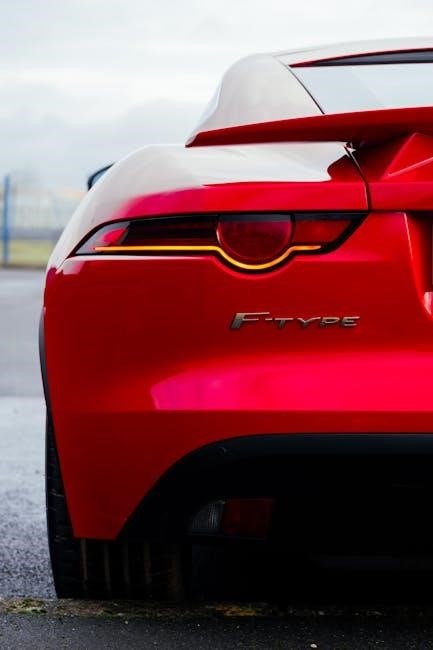
The Jaguar S-Type‚ introduced in 1998‚ combines classic styling with modern performance. Known for its smooth handling and refined interior‚ it offers a range of engine options‚ including diesel and V8 variants. A popular choice for luxury and power‚ it remains a sought-after used vehicle‚ though buyers should be mindful of potential issues like body rot and maintenance requirements.
History and Development

The Jaguar S-Type‚ introduced in 1998‚ marked a significant step in Jaguar’s evolution‚ blending classic styling cues with modern engineering. Designed to replace the XJ Series‚ it was codenamed XJ40 during development. The S-Type was aimed at combining the elegance of Jaguar’s heritage with contemporary performance and technology. Its design drew inspiration from the 1960s S-Type‚ featuring a curved roofline and traditional chrome accents‚ while incorporating advanced features like air suspension and a sophisticated interior.
Over its production run‚ the S-Type underwent several updates‚ including the introduction of diesel engines in 2001 and the high-performance S-Type R in 2002‚ which featured a 4.2-liter supercharged V8. The model was discontinued in 2008‚ making way for the XF. Despite its relatively short production span‚ the S-Type remains a notable example of Jaguar’s balance between tradition and innovation‚ appealing to enthusiasts of both classic and modern designs.
- Launched in 1998 as a successor to the XJ Series.
- Featured a range of engines‚ including V6‚ V8‚ and diesel options.
- The S-Type R variant offered high-performance capabilities.
- Production ended in 2008‚ replaced by the XF model.
Key Features and Options
The Jaguar S-Type offers a blend of luxury and performance‚ featuring a range of engine options‚ including V6‚ V8‚ and diesel variants. It comes with automatic transmissions‚ leather interiors‚ and advanced features like air suspension. Optional upgrades include premium audio systems and navigation.
3.1 Engine Variants

The Jaguar S-Type offers a diverse range of engine options‚ catering to different preferences and needs. The lineup includes the 2.7 TDV6 diesel engine‚ known for its fuel efficiency and torque‚ as well as petrol variants like the 2.5 V6‚ 3.0 V6‚ and the powerful 4.0 V8. For those seeking enhanced performance‚ the 4.2 V8 and the supercharged 4.2 V8 engines deliver exceptional power and acceleration. Each engine variant provides a unique driving experience‚ from the economical diesel option to the high-performance V8 models. Regular oil pressure checks are recommended‚ especially for the XK twin-cam engine‚ to ensure optimal performance and longevity. Proper maintenance‚ including timely oil changes‚ is crucial to prevent potential issues and maintain the vehicle’s reliability. Buyers should consider their driving habits and priorities when selecting the most suitable engine type for their needs.

3.2 Transmission Options

The Jaguar S-Type is equipped with a range of transmission options designed to complement its engine variants. Most models feature a five-speed automatic transmission‚ while later versions may have a six-speed automatic for smoother gear shifts. These automatic transmissions are generally reliable but require regular maintenance to ensure optimal performance. Neglecting fluid changes or ignoring signs of wear can lead to issues over time. Additionally‚ some early models offer a manual transmission option‚ which‚ although less common‚ is sought after by driving enthusiasts for its precise control and engaging driving experience.
When evaluating a used S-Type‚ it’s important to assess the transmission’s condition. Look for smooth gear transitions and check for any signs of leakage or unusual noises. The automatic transmissions are well-suited for city driving and long cruises‚ while the manual option appeals to those who prefer a more hands-on driving experience. Proper maintenance‚ including regular fluid checks and timely repairs‚ is essential to extend the lifespan of the transmission and ensure a seamless driving experience.

3.3 Interior Features
The Jaguar S-Type boasts a luxurious interior that reflects the brand’s commitment to comfort and elegance. The cabin is adorned with premium materials‚ including leather upholstery and walnut wood trim‚ evoking a classic British charm. The dashboard design is intuitive‚ with controls logically arranged for ease of use. The J-gate gear selector‚ a hallmark of Jaguar‚ adds a touch of sophistication to the center console.
Seating is comfortable and supportive‚ with optional heated and electrically adjustable seats available in higher trim levels. Rear passengers benefit from ample legroom‚ making the S-Type a practical choice for families or those who frequently carry passengers. The trunk space is generous‚ offering sufficient storage for luggage or other items.
Later models‚ particularly the 2008 facelift‚ introduced updated interior materials and a more modern design aesthetic. Optional features such as a premium audio system and navigation further enhance the driving experience. Overall‚ the S-Type’s interior strikes a balance between timeless luxury and functional practicality‚ appealing to both enthusiasts and everyday drivers.
3.4 Exterior Design
The Jaguar S-Type features a classic‚ elegant exterior design that pays homage to Jaguar’s heritage while incorporating modern styling cues. Its sleek‚ aerodynamic profile is complemented by a long hood and short rear deck‚ creating a balanced and sophisticated appearance. The car’s retro-inspired lines‚ particularly in earlier models‚ draw influence from the iconic Jaguar Mk II‚ appealing to enthusiasts of classic design.
The S-Type’s exterior is characterized by chrome accents‚ subtle curves‚ and a prominent grille that embodies Jaguar’s signature styling. The use of high-quality materials ensures durability‚ though buyers should be vigilant about rust-prone areas‚ such as the sills and wheel arches‚ which can deteriorate over time if not properly maintained. Later models‚ including the 2008 facelift‚ introduced updated exterior elements like bi-xenon headlights and a revised front grille‚ aligning the S-Type more closely with Jaguar’s contemporary design language.
Overall‚ the S-Type’s exterior design blends timeless elegance with a sporty demeanor‚ making it a standout choice for those who appreciate both luxury and classic aesthetics. Regular maintenance and inspections are crucial to preserving its visual appeal and structural integrity.

Buying Considerations
When purchasing a Jaguar S-Type‚ consider model year variations‚ engine performance‚ and transmission reliability. Check for common issues like body rot and oil pressure consistency. Review the vehicle’s history and maintenance records to ensure reliability and avoid costly repairs. Proper evaluation is key to a smart purchase.
4.1 Understanding Model Year Variations
Understanding model year variations is crucial when buying a Jaguar S-Type. The S-Type was produced from 1998 to 2008‚ with significant updates over the years. Early models (1998-2002) featured the 3.0 V6 and 4.0 V8 engines‚ while later years introduced the 2.7 TDV6 diesel in 2004. The 2008 facelift brought styling tweaks and improved interior features. Buyers should note that post-2005 models received updated engines‚ including the 4.2 V8‚ which offered better performance and reliability. Additionally‚ later models often came with advanced options like navigation and improved safety features. When evaluating‚ consider the year’s specific engine offerings‚ as some‚ like the 2.7 TDV6‚ are known for better fuel efficiency but may have higher maintenance costs. Earlier models may lack modern amenities but could be more affordable. Researching the exact model year and its updates can help buyers make an informed decision‚ ensuring they find a vehicle that balances performance‚ features‚ and budget;
4.2 Evaluating the Engine and Transmission
Evaluating the engine and transmission is a critical step when buying a Jaguar S-Type. The S-Type offers a range of engines‚ including the 2.7 TDV6 diesel‚ 3.0 V6‚ 4.0 V8‚ and the powerful 4.2 Supercharged V8. The 2.7 TDV6 is known for its fuel efficiency but may require more frequent maintenance due to its diesel nature. The V8 engines‚ particularly the 4.2‚ deliver strong performance but can be thirstier and may develop issues like oil pressure problems if not properly serviced. Most S-Types come with a 5-speed automatic transmission‚ while later models feature a 6-speed automatic‚ both of which are generally reliable but can suffer if neglected. Buyers should check for consistent oil pressure‚ especially in the XK twin-cam engine‚ and listen for any unusual noises from the bottom end. Transmission fluid levels and condition should also be inspected‚ as neglect can lead to premature wear. Ensuring the engine and transmission are well-maintained is essential for long-term reliability and performance.
4.3 Checking for Common Issues
When evaluating a Jaguar S-Type‚ it’s essential to check for common issues that could impact its reliability and value. One major concern is body rot‚ particularly in the sills‚ which can deteriorate over time due to moisture exposure. This issue can be costly to repair if left unaddressed. Additionally‚ electrical problems are not uncommon‚ with areas like the dashboard‚ central locking‚ and alarm systems often requiring attention. Engine-wise‚ the 2.7 TDV6 diesel engine‚ while fuel-efficient‚ may require more frequent maintenance due to its design. Oil pressure should be monitored‚ especially in the XK twin-cam engine‚ and any unusual noises from the bottom end should be investigated. Transmission issues can also arise‚ particularly if fluid levels are neglected. Buyers should also look out for signs of wear in the suspension and steering systems‚ as these can affect handling and safety. A thorough inspection by a qualified mechanic is highly recommended to identify any hidden problems. Addressing these issues early can help ensure the vehicle remains reliable and performs at its best.
4.4 Assessing the Vehicle’s History
Assessing the history of a Jaguar S-Type is crucial for making an informed purchase. Start by obtaining a detailed service history‚ including records of routine maintenance‚ repairs‚ and any major work. Check for consistency in the mileage logged during services and ensure all recalls have been addressed. Use a VIN decoder to verify the car’s specifications and ensure it matches the seller’s description. Look for signs of regular oil changes‚ as neglecting these can lead to engine and transmission issues. Review the vehicle’s ownership history to identify if it has had multiple owners or been used for commercial purposes‚ which may indicate higher wear and tear. Additionally‚ check for any accident or damage reports‚ as unresolved structural issues can lead to costly repairs. Finally‚ inspect the car for any unauthorized modifications‚ as these can void warranties or affect performance. A clean‚ well-documented history is a strong indicator of a reliable vehicle. Always consider a pre-purchase inspection to uncover any hidden issues. This step can save you from future headaches and financial losses.

Maintenance and Upkeep

Regular maintenance is essential for the Jaguar S-Type. Follow the recommended schedule‚ with services every 16‚000 miles or one year. Use Castrol EDGE Professional E C5 0W-20 for optimal performance. Regular oil and filter changes are critical to prevent engine issues. Neglecting maintenance can lead to costly repairs‚ so always prioritize routine checks and address any concerns promptly to ensure longevity and reliability.
5.1 Routine Maintenance Schedule
Regular maintenance is crucial for the Jaguar S-Type to ensure optimal performance and longevity. The recommended maintenance schedule suggests services at intervals not exceeding 16‚000 miles or one year‚ whichever comes first. This routine includes oil and filter changes‚ tire pressure checks‚ and inspections of key components like brakes and belts. Additionally‚ fluid levels‚ including coolant‚ transmission‚ and differential oils‚ should be monitored and topped up as needed. It’s also important to use the specified Castrol EDGE Professional E C5 0W-20 oil to maintain fuel efficiency and reduce emissions. During these services‚ technicians should check for signs of wear on suspension components‚ exhaust systems‚ and electrical connections. Proper adherence to this schedule helps prevent costly repairs and ensures the vehicle runs smoothly. Neglecting routine maintenance can lead to premature wear and potential failures‚ especially in the engine and transmission. By following the manufacturer’s guidelines‚ owners can preserve the S-Type’s performance and reliability over time.
5.2 Oil and Fluid Requirements
The Jaguar S-Type requires specific oil and fluids to maintain its performance and longevity. The recommended engine oil is Castrol EDGE Professional E C5 0W-20‚ which is jointly developed with Jaguar Land Rover. This oil improves fuel efficiency‚ reduces CO2 emissions‚ and ensures optimal engine protection. It’s crucial to use the correct viscosity and type of oil to prevent damage and maintain the engine’s performance. Regular oil changes are essential‚ typically every 5‚000 to 7‚500 miles‚ depending on driving conditions. Additionally‚ other fluids such as coolant‚ transmission fluid‚ and differential oil should be checked and topped up during routine maintenance. Using the wrong fluids can lead to costly repairs and premature wear. Owners should refer to the owner’s manual or consult a Jaguar specialist for the correct specifications. Neglecting oil and fluid maintenance can result in engine damage‚ reduced fuel efficiency‚ and potential breakdowns. Proper fluid management is vital to preserving the S-Type’s reliability and ensuring it runs smoothly for years to come.
